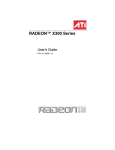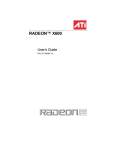Download ATI Technologies Radeon 9800 Series User`s guide
Transcript
RADEON™ 9800 SERIES User’s Guide P/N 137-40462-30 Copyright © 2003, ATI Technologies Inc. All rights reserved. ATI and all ATI product and product feature names are trademarks and/or registered trademarks of ATI Technologies Inc. All other company and/or product names are trademarks and/or registered trademarks of their respective owners. Features, performance and specifications are subject to change without notice. Product may not be exactly as shown in the diagrams. Reproduction of this manual, or parts thereof, in any form, without the express written permission of ATI Technologies Inc. is strictly prohibited. Disclaimer While every precaution has been taken in the preparation of this document, ATI Technologies Inc. assumes no liability with respect to the operation or use of ATI hardware, software or other products and documentation described herein, for any act or omission of ATI concerning such products or this documentation, for any interruption of service, loss or interruption of business, loss of anticipatory profits, or for punitive, incidental or consequential damages in connection with the furnishing, performance, or use of the ATI hardware, software, or other products and documentation provided herein. ATI Technologies Inc. reserves the right to make changes without further notice to a product or system described herein to improve reliability, function or design. With respect to ATI products which this document relates, ATI disclaims all express or implied warranties regarding such products, including but not limited to, the implied warranties of merchantability, fitness for a particular purpose, and non-infringement. Product Notice MACROVISION A. Apparatus Claims of U.S. Patent Nos. 4,631,603, 4,577,216, 4,819,098, and 4,907,093 licensed for limited viewing users only. B. In the printed collateral material that accompanies the Product, the following notice must be printed in an appropriate place in such materials: This product incorporates copyright protection technology that is protected by method claims of certain U.S. patents and other intellectual property rights owned by Macrovision Corporation and other rights owners. Use of this copyright protection technology must be authorized by Macrovision Corporation, and is intended for home and other limited viewing uses unless otherwise authorized by Macrovision Corporation. Reverse engineering or disassembly is prohibited. i Table of Contents Disclaimer...................................................................................................... i Product Notice......................................................................................... i Introduction. . . . . . . . . . . . . . . . . . . . . . . . . . . . . . . . . . 1 Features At A Glance .................................................................................. 2 ATI’s CATALYST™ Software Suite ........................................................ 3 Multiple Displays and 3D Gaming Experience...................................... 3 Direct 3D and OpenGL .......................................................................... 3 HYDRAVISION™ ................................................................................ 4 Multiple Displays . . . . . . . . . . . . . . . . . . . . . . . . . . . . . 5 Connecting Your Monitor(s) ...................................................................... 5 Display Configurations................................................................................ 6 CATALYST Software Suite . . . . . . . . . . . . . . . . . . . . . 7 ATI Displays Tab......................................................................................... 7 Enabling/Disabling Secondary Displays ................................................ 8 Enabling Extended Desktop Mode......................................................... 8 Dynamic Display Reassignment ............................................................ 8 Virtually Repositioning Your Displays .................................................. 9 Ratiometric Expansion ......................................................................... 10 ATI Color Tab ........................................................................................... 11 Color Hotkeys Settings......................................................................... 14 ATI Options Tab........................................................................................ 15 ATI Overlay Tab ....................................................................................... 17 Video Overlay ...................................................................................... 17 Clone Mode Settings ............................................................................ 19 Direct 3D Control Panel . . . . . . . . . . . . . . . . . . . . . . . 20 Main and Custom Settings........................................................................ 20 Direct 3D Compatibility Settings ............................................................. 23 OpenGL Control Panel . . . . . . . . . . . . . . . . . . . . . . . . 24 Main and Custom Settings........................................................................ 24 OpenGL Compatibility Settings............................................................... 27 SMARTGART™ . . . . . . . . . . . . . . . . . . . . . . . . . . . . . . 30 Set AGP Settings .................................................................................. 30 Fast Write ............................................................................................. 30 Retest All .............................................................................................. 31 ii Using TV Out. . . . . . . . . . . . . . . . . . . . . . . . . . . . . . . . 32 View your PC’s display on a TV .............................................................. 32 Connecting to a TV or a VCR .................................................................. 33 Starting Windows® with TV Display Enabled .................................... 34 To Enable/Disable The TV Display.......................................................... 35 Using and Adjusting TV Out................................................................ 35 How TV Display Cannot Be Used ....................................................... 35 Using a Monitor vs. Using the TV Display.......................................... 36 Reducing Edge Distortion ......................................................................... 38 Changing Display Configurations............................................................ 39 Using Games and Applications................................................................. 39 NSTC/PAL Support for RADEON 9800 Series...................................... 40 iii 1 Introduction The RADEON™ 9800 Series graphics accelerator delivers unsurpassed 3D graphics performance. • Powered by the RADEON 9800 Series Visual Processing Unit (VPU). • Third generation to support the latest Microsoft® DirectX® 9.0 and OpenGL features. • Cinematic experience with a new level of quality and consistency. • Third generation 8-pixel pipeline architecture. • Support for AGP 8X specification. • 256-bit DDR memory interface. • Support Direct 3D® and OpenGL® applications. • High resolution in 3D up to 2048x1536. • Flat panel support. • Supports TV-Out to connect your PC to your TV or VCR. 2 Features At A Glance The RADEON 9800 Series includes: • CINEMATIC RENDERING: With its highly programmable cinematic shader engines, the RADEON 9800 Series of visual processors are designed to bring the most detailed worlds to life with motion picture effects. • UNSURPASSED 3D PERFORMANCE: Eight parallel rendering pipelines, 256-bit memory interface, blazing fast clock speeds, and AGP 8X support come together to deliver incredible performance at the highest resolutions and detail settings for the most demanding next generation 3D titles, scenes and environments. • Virtual Perfection: Experience unparalleled 3D visual realism. Combining SMOOTHVISION™ 2.1 and SMARTSHADER™ 2.1, the RADEON 9800 Series enables smooth, sharp, hyper-realistic interactive imagery. • QUALITY VIDEO PLAYBACK: Revolutionary VIDEOSHADER™ and FULLSTREAM™ technologies provide the cleanest video playback available on a PC. • FLEXIBLE DISPLAY CONFIGURATIONS: Enhance your work environment with multiple displays, TV-output support, and high resolutions. 3 ATI’s CATALYST™ Software Suite Multiple Displays and 3D Gaming Experience ATI’s CATALYST Software Suite provides multiple display functionality, and the advanced graphic features, such as SMARTSHADER 2.1, for the ultimate 3D gaming experience. For help installing the CATALYST Software Suite, refer to the Getting Started Guide. The CATALYST Software Suite installs the ATI display tabs. These tabs are accessed through the Windows® Display Control Panel, through the Advanced... button located on the Settings tab. For a detailed explanation of each ATI tab, refer to the sectionCATALYST Software Suite on page 7. Direct 3D and OpenGL The CATALYST Software Suite also supports the latest versions of Direct 3D and OpenGL. Many new 3D game titles, and the latest versions of older titles, will virtually come to life as they utilize their advanced Direct 3D or OpenGL features. Gamers can fine-tune these settings for the ultimate experience in 3D image quality or 3D gaming performance. ATI’s Direct 3D and OpenGL tabs are available through the Windows® Display Control Panel, through the Advanced... button located on the Settings tab. For a detailed explanation of the Direct 3D and OpenGL tabs, refer to Direct 3D Control Panel on page 20, and OpenGL Control Panel on page 24. 4 HYDRAVISION™ In addition to the multiple display functionality available with ATI’s CATALYST Software Suite, you can also use HYDRAVISION for advanced multi-monitor management. For more information on HYDRAVISION, please refer to the HYDRAVISION User’s Guide PDF located on your ATI Installation CD. 5 Multiple Displays Connecting Your Monitor(s) Your RADEON 9800 Series provides hardware support for one DVI-I monitor or two VGA monitors using the supplied DVI-I-to-VGA adapter. A TV can also be used to expand your desktop by using the S-Video out. Plug the monitor cable into your card (if you are running multiple monitors, connect their cables to the appropriate connectors), then turn on the PC and monitor(s). To connect a flat panel directly to your card, use the DVI-I connector. To connect a VGA monitor to the DVII connector, plug the supplied DVI-I-to-VGA adapter into the DVI-I connector, then plug your monitor cable into the adapter, as shown below. STANDARD VGA MONITOR CONNECTOR S-VIDEO OUT VGA CONNECTOR FROM MONITOR DVI-I CONNECTOR DVI-I-TO-VGA ADAPTER VGA CONNECTOR FROM MONITOR When you use multiple monitors with your card, one monitor will always be Primary. Any additional monitor(s) will be designated as Secondary. 6 Display Configurations Your RADEON 9800 Series graphics accelerator card provides dual display functionality and TV Out. The following table lists the different ways you can connect displays to your card. Display Configuration Connector(s) Used Comments One CRT display VGA connector OR DVII connector with DVI-Ito-VGA adapter CRT- cathode ray tube analog display One DFP display DVI-I connector DFP - digital flat panel display One TV S-Video out The S-Video out can also support a composite connection via the S-Videoto-Composite adapter CRT display + TV VGA connector + S-Video out Unsupported configuration if the CRT display is attached to the DVI-I connector via the DVI-I-to-VGA adapter DFP display + TV DVI-I connector + S-Video out CRT display + DFP display VGA connector + DVI-I connector CRT display + CRT display VGA connector + DVI-I connector with DVI-I-toVGA adapter The DVI-I connector can support a CRT display using the DVI-I-to-VGA adapter CRT display + DFP display + TV VGA connector + DVI-I connector + S-Video out The TV display will “clone” the image of one of the other two displays. CRT display + CRT display + TV UNSUPPORTED CONFIGURATION 7 CATALYST Software Suite The following section provides an explanation of each ATI tab added to the Display Properties after installing the Catalyst Software Suite. i Features presented in the following pages may not be supported in all operating systems and/or may appear differently. ATI Displays Tab The ATI Displays tab provides multiple monitor features. Here you can enable/disable display devices and swap the assignment of Primary and Secondary displays. 8 Enabling/Disabling Secondary Displays 1 Access the Windows® Control Panel. Double-click Display. 2 Click the Settings tab and then the Advanced... button. 3 Click the ATI Displays tab. 4 Click the enable/disable button for the display device you want to enable/disable. 5 Click OK or Apply to save the changes. Enabling Extended Desktop Mode 1 Access the Windows® Control Panel. Double-click Display. 2 Click the Settings tab. 3 Click the monitor icon for the display onto which you want to extend your desktop. 4 Click Yes to enable the selected display. 5 Checkmark the Extend my Windows desktop onto this monitor check box (Windows® may automatically place it there). 6 Click OK or Apply to save the changes. Dynamic Display Reassignment You can change the assignment of your Primary and Secondary display on the fly, without rebooting. However, before you can change the assignment of the Primary display, at least one Secondary display must be enabled, and Extended Desktop mode must be enabled. 9 To enable a Secondary display see Enabling/Disabling Secondary Displays on page 8. To enable Extended Desktop Mode see Enabling Extended Desktop Mode on page 8. 1 Access the Windows® Control Panel. Double-click Display. 2 Click the Settings tab and then the Advanced... button. 3 Click the ATI Displays tab. The ATI Displays tab shows you the display(s) that are active. The Primary display has the button depressed. To change the display assignment, click the Primary display’s button or click the button of the other display device. In Windows® 2000 clicking the button will reassign the Primary and Secondary monitors. Clicking the button creates a clone or mirror image of the Primary display onto the Secondary display. Clicking the button extends your desktop to a Secondary display located to the right of the Primary display. Clicking the button extends your desktop to a Secondary display located below the Primary display. 4 Click OK or Apply to save the changes. Virtually Repositioning Your Displays 1 On the Settings tab, click and drag the appropriate monitor icon to the desired position. For example, the secondary display can be dragged to the left of the primary display, allowing it to be virtually on the left, as shown below. 10 2 Click OK or Apply to save the changes. Ratiometric Expansion Your RADEON 9800 Series offers ratiometric expansion (or digital panel scaling as it is commonly known). This expands a low resolution image to fill a higher resolution panel. However, ratiometric expansion is only available on the Primary display. Therefore, if a flat panel display (FPD) is set as Secondary, the Extended Desktop mode is disabled and the resolution is less than the FPD’s native resolution. This causes the FPD to default to center mode. 11 ATI Color Tab The ATI Color Properties page allows you to configure Gamma, Brightness, and Contrast color settings for both your desktop and full screen 3D environments. You can also save settings to a color Profile for easy recall later. In addition, you can assign unique hotkey combinations that allow you to adjust Gamma, Brightness, and Contrast color settings within your full screen 3D applications. To create a new profile, simply adjust the sliders to the desired settings, type in a profile name, and click Save. You can easily create and manage multiple color profiles, both for your desktop and full screen 3D environments. To restore the settings for a Desktop profile, simply select the profile name from the drop-down list box, and click Apply or OK. To restore the settings for a Full Screen 3D profile, select the profile name from the drop-down list box, then start your 3D application in full screen mode. Depending on the 3D application, you may need to load your selected profile using assigned hotkeys, once your 3D application is running (refer to the Notes). To assign hotkeys for adjusting the color settings within your full screen 3D applications, select the Full Screen 3D radio button, then click the Hotkeys button to access the Hotkeys dialog. NOTE: Some 3D applications load their own Color settings when they first start, not the Color page settings. You can change the color settings once the 3D application is running, using the assigned hotkeys. The easiest way is to select a Full Screen 3D profile name from the drop-down list box and click OK, start your 3D application in full screen mode, then load the selected profile using the hotkeys assigned to the "Load Current Profile" action (on the Hotkeys dialog). This will change the settings within your 3D application environment. 12 NOTE: Some 3D applications can switch easily between full screen mode and windowed mode, and do not load their own Color settings. In windowed mode, you can make slider adjustments or select a different profile, then switch back to full screen mode to see the effect immediately. NOTE: When assigning hotkeys, you need to be especially careful that the assigned keys do not conflict with a 3D application's function keys, or hotkeys assigned by other applications. The ATI Color page only checks for duplicates within the Color page itself (you can only assign one hotkey combination per action). ATI Color Tab for the Desktop ATI Color Tab for Full Screen 3D Desktop radio button Select Desktop to configure your desktop color settings. Full Screen 3D radio button Full Screen 3D to configure the color settings for your 3D application. Note that the configured settings will only be apparent within a full screen 3D application environment. Profiles for: Indicates whether the profile in current use is for your Desktop or a Full Screen 3D environment. 13 Profiles dropdown list Lists all of the Desktop or Full Screen 3D profiles that you have saved. Selecting a profile from the list loads those custom color settings for either your Desktop or your full screen 3D application (depending on the state of the radio buttons). To create a new profile, simply type in a name and click Save. Save button Click this to save your current color settings to a Desktop or Full Screen 3D profile, using the name you specified in the list box. To restore these settings later, simply select the Profile name from the list and click Apply or OK. Delete button Deletes the profile that is selected in the Profiles list box. All Colors checkbox All Colors</b> to adjust the Gamma, Brightness or Contrast for Red, Green, and Blue simultaneously. Note that any individual color settings made are lost if All Colors is selected, and the color settings revert back to the previous All Colors settings. Red Green Blue radio buttons Adjusts the Gamma, Brightness or Contrast only for the selected color component (Red, Green, or Blue). Note that any individual color settings made are lost if you select All Colors again. Gamma slider Increases or decreases the gamma correction of your Desktop or full screen 3D application. Changing the gamma alters the curvature of the color curve. Brightness slider Increases or decreases the color brightness of your Desktop or full screen 3D application. Changing the brightness adjusts the vertical position of the color curve. Contrast slider Increases or decreases the color contrast of your Desktop or full screen 3D application. Changing the contrast adjusts the slope of the color curve. Reset buttons Click this to restore the individual slider setting to its default value, then click Apply or OK. Color preview box The color image indicates visually how the Gamma, Brightness and Contrast sliders affect the final color settings of your display device. In Desktop mode, clicking on this with your mouse pointer will change the image. 14 Hotkeys button Click this to open the Color Hotkeys Settings dialog. There you can assign hotkeys for adjusting your color settings within a full screen 3D application environment. To activate this button, you must select the Full Screen 3D radio button. Defaults button Click this to restore all of the color settings to the default values, then click Apply or OK. Color Hotkeys Settings Modifier key Modifier key, which can be any combination of Alt, Ctrl, or Shift. Note that the Shift key will be used in conjunction with either the Ctrl or the Alt key. Hotkey Hotkey, which can be any key listed. To avoid conflicts, be mindful of any hotkeys or keyboard controls that may already be assigned to your applications and 3D games. Hotkey action Specify an action that the assigned hotkeys will control within a full screen 3D application environment. You can only assign one hotkey combination to each action. Assigned hotkeys Lists the assigned hotkeys, and which action each hotkey combination will control. 15 Add button Add a hotkey combination to the assigned list. Remove button Remove a hotkey combination from the assigned list. Disable hotkeys checkbox Disables all hotkeys. To disable a single hotkey combination, remove it from the assigned list. ATI Options Tab The ATI Options tab provides detailed driver information and access to the card’s specifications. You can also enable or disable the ATI taskbar icon. 16 ATI Options Tab Version Information Provides the Catalyst version number, 2D version number and the driver build information. Details button Provides access to the Details tab which lists the card’s hardware details and driver information. Reactivate all warning messages This allows you to reactivate any disabled graphics warning messages. Enable ATI taskbar icon application Unchecking this allows you to disable the ATI taskbar applications and removes the ATI icon from your system tray. Show ATI icon on taskbar Unchecking this allows you to remove the ATI icon from your system tray without disabling the ATI icon applications. Disable quick resolution feature Quick resolution feature is accessible by leftclicking the ATI icon in the system tray. Checking this option disables this feature. Reduce DVI frequency on highresolution Resolves display corruption or no image at high resolutions (for example 1280x1024 @75Hz) using a digital DVI display. (This setting has no effect when using a DVI-toVGA adapter.) Alternate DVI operational mode Use this option if you are experiencing display corruption on your DVI flat panel. Clicking the Details button provides graphics card, graphics driver and system information. 17 ATI Overlay Tab The ATI Overlay tab allows you to configure the brightness, contrast, saturation, hue and gamma properties of your video overlay. Video Overlay Video overlay allows for the viewing of streaming video on your PC. However, there is only one video overlay, which is only available on the Primary display. The video overlay controls are automatically activated during playback of any video file type that supports overlay adjustments. 18 ATI Overlay Tab Brightness Use this slider to adjust the brightness of the video image. Contrast Use this slider to adjust the contrast in the video image. Saturation Use this slider to adjust the vividness of the color. Sliding it all the way to the left removes all color and produces a black and white picture. Hue Use this slider to adjust the pureness or tint of the red, green and blue components of the color. Gamma Use this slider to adjust the overall intensity of the video image. Clone mode options Click this button to access Clone Mode overlay settings.These settings only apply to video content when viewed in dual-controller Clone mode. Defaults button This allows you to reset the Overlay settings to default values. Theater Mode This allows you to display video playback in full screen on a secondary monitor, if available and enabled. 19 Clone Mode Settings Clone Mode Options Standard Video content is displayed on your Primary display only. Theater Mode Video content is displayed on your Primary and Secondary displays. Video content is displayed on your Secondary display(s) is always in full screen mode. Note: your computer must be set for 16-bit color depth or higher to use this mode. Same on all Video content is displayed on your Primary and Secondary display is exactly the same manner. For example, all displays will show video output in full screen mode. Theater Mode Settings These settings are available when Theater Mode is selected. Same as source video The aspect ratio of the source video is maintained for full screen display. Note: that this option may result in black bars on either the horizontal or vertical sides of the video display. Full Screen Video The source video is scaled so that your display is showing full screen. Note: if the source video contains horizontal black bars, as do some DVD movies, the full screen video will also contain black bars. 4:3 (Standard TV) Select this option if the aspect ratio of the display device showing full screen video has the standard 4:3 aspect ratio (standard TVs and monitors). 16:9 (Widescreen) Select this option if the aspect ratio of the display device is showing full screen video has a 16:9 aspect ratio (widescreen HDTVs). 20 Direct 3D Control Panel Using this tab, you can fine-tune the settings for Direct 3D applications. Main and Custom Settings The Main Settings allows you to optimize for performance by moving the slider to the left, or improve overall image quality by moving the slider to the right. Selecting Custom Settings disables the Main Settings slider and allows you to fine-tune the Direct3D settings of your RADEON 9800 Series. 21 Main Settings slider This allows you to select the kind of application experience you’d like to have. Moving the slider to the left will maximize application performance, while moving the slider to the right will optimize 3D image quality. Moving this slider from one position to the next changes the individual Custom Settings sliders found below. Custom Settings checkbox When Custom Settings is checked, the Main Settings slider is disabled, allowing you to move each individual slider in the Custom Settings section below. Setting the individual sliders gives you finer control over your application experience. Using Custom Settings is recommended for advanced users only. SMOOTH VISION 2.1 Anti-Aliasing SmoothVision 2.1 Anti-Aliasing improves image quality by removing jagged edges from 3D images, resulting in smoother, more naturallooking lines and contours. Selecting Application Preference will result in high quality images, with negligible reduction in the application’s performance. SMOOTH VISION 2.1 slider SmoothVision 2.1 Anti-Aliasing can be applied using different number of samples (2X, 4X, 6X). More samples provide more realistic 3D images. SMOOTH VISION 2.1 Anisotropic Filtering checkbox Anisotropic filtering uses a texture filtering technique that blends multiple texture samples together. Selecting Application Preference will result in sharper textures, with a negligible reduction in the application’s performance. SMOOTH VISION 2.1 Anisotropic Filtering slider The number of samples taken when anisotropic filtering is performed can vary. By moving this slider to the right, the number of samples taken increases and the quality of the final image increases. 16X provides maximum detail, crisplooking images as a result of the largest number of texture samples possible. 22 Texture Preference slider Selecting this decides whether your application should use high quality or high performance textures. Moving the slider to the right delivers the highest quality experience. Moving the slider to the left emphasizes a high performance solution while still providing good visuals. Mipmap Detail Level slider This will allow you to choose the texture quality of the mipmaps the application will use. Mipmaps are a collection of different sized textures of the same image. As the user moves closer to a 3D object the image quality should increase, requiring a higher quality texture of the same image. The base mipmap is the highest quality texture, and all subsequent mipmaps are smaller sized textures of the same image. Moving the slider to the right improves image quality, and moving the slider to the left degrades image quality. Wait for Vertical Sync Wait for vertical sync will lower the frame rate of full screen games but reduce the image tearing that can occur with the higher frame rate. Selecting Application Preference allows the application to decide whether or not it should display its frames at the refresh rate of the monitor. Selecting Always Off allows the application to run at its highest possible frame rate, regardless of the monitor’s refresh rate which is typically less than the frame rate at which the application will run. TRUFORM Truform uses High Order Surface geometry to generate more detailed and realistic terrain and character models for applications that support this technology. Select Application Preference to enable Truform. Select Always Off to disable Truform. Compatibility Settings button This button allows you to access advanced settings that can solve compatibility issues for a few specific Direct 3D applications. Defaults This button allows you to reset the Direct3D settings to default values. 23 Direct 3D Compatibility Settings Support DXT texture formats May eliminate problems with certain Direct 3D games that display vertical and horizontal lines around textures or display text incorrectly. This setting should only be Enabled if you are experiencing these issues, as it may cause problems with other games. Alternate pixel center This may eliminate problems with some Direct 3D games which display vertical and horizontal lines around textures, or text that appears incorrect. However, this setting should only be used if you are experiencing the symptoms mentioned, as it may cause problems with other games. Defaults button This button allows you to reset the Direct 3D Compatibility Settings to default values. 24 OpenGL Control Panel Using this tab, you can fine-tune the settings for OpenGL applications. Main and Custom Settings In the Main Settings you can maximize overall performance by moving the slider to the left, or you can enhance overall image quality by moving the slider to the right. Selecting Custom Settings disables the Main Settings slider allowing you to fine-tune the OpenGL settings of your RADEON 9800 Series. 25 Main Settings slider This allows you to select the kind of application experience you’d like to have. Moving the slider to the left will maximize application performance, while moving the slider to the right will optimize 3D image quality. Moving this slider from one position to the next changes the individual Custom Settings sliders found below. Custom Settings checkbox When Custom Settings is checked, the Main Settings slider is disabled, allowing you to move each individual slider in the Custom Settings section below. Setting the individual sliders gives you finer control over your application experience. Using Custom Settings is recommended for advanced users only. SMOOTH VISION 2.1 Anti-Aliasing SmoothVision 2.1 Anti-Aliasing improves image quality by removing jagged edges from 3D images, resulting in smoother, more naturallooking lines and contours. Selecting Application Preference will result in high quality images, with negligible reduction in the application’s performance. SMOOTH VISION 2.1 Anisotropic Filtering checkbox Anisotropic filtering uses a texture filtering technique that blends multiple texture samples together. Selecting Application Preference will result in sharper textures, with a negligible reduction in the application’s performance. SMOOTH VISION 2.1 Anisotropic Filtering slider The number of samples taken when anisotropic filtering is performed can vary. By moving this slider to the right, the number of samples taken increases, and the quality of the final image increases.16X provides maximum detail, crisplooking images as a result of the largest number of texture samples possible. SMOOTH VISION 2.1 slider SmoothVision 2.1 Anti-Aliasing can be applied using different number of samples (2X, 4X, 6X). More samples provide more realistic 3D images. 26 Texture Preference slider Selecting this decides whether your application should use high quality or high performance textures. Moving the slider to the right delivers the highest quality experience. Moving the slider to the left emphasizes a high performance solution while still providing good visuals. Mipmap Detail Level slider This will allow you to choose the texture quality of the mipmaps the application will use. Mipmaps are a collection of different sized textures of the same image. As the user moves closer to a 3D object the image quality should increase, requiring a higher quality texture of the same image. The base mipmap is the highest quality texture, and all subsequent mipmaps are smaller sized textures of the same image. Moving the slider to the right improves image quality, and move the slider to the left degrades image quality. Wait for Vertical Sync Wait for vertical sync will lower the frame rate of full screen games but reduce the image tearing that can occur with the higher frame rate. Selecting Application Preference allows the application to decide whether or not it should display its frames at the refresh rate of the monitor. Selecting Always Off allows the application to run at its highest possible frame rate, regardless of the monitor’s refresh rate which is typically less than the frame rate at which the application will run. TRUFORM Truform uses High Order Surface geometry to generate more detailed and realistic terrain and character models for applications that support this technology. Select Application Preference to enable Truform. Select Always Off to disable Truform. Compatibility Settings button This button allows you to access advanced settings that can solve compatibility issues for a few specific OpenGL applications. Defaults This button allows you to reset the OpenGL settings to default values. 27 OpenGL Compatibility Settings Force Z-buffer depth This allows you to explicitly set the Z-Buffer depth. Most applications will work best when Disabled is selected Triple Buffering Enabling this feature improves a game’s frame rate when vertical sync is enabled. This only applies if the frame rate is less than the vertical sync refresh rate. In low memory situations, enabling this feature may impact application performance. Triple Buffering will be automatically disabled if there is insufficient available memory. 28 OpenGL Hardware Acceleration This feature must be enabled for hardware acceleration of OpenGL applications. This setting should only be disabled if you are experiencing serious rendering problems. Disabling this feature will significantly decrease OpenGL performance. Defaults button This button allows you to reset the OpenGL Compatibility Settings to default values. 29 30 SMARTGART™ SMARTGART is a suite of testing and diagnostics tools that perform a variety of bus tests to determine the optimal settings for your ATI graphics accelerator installed in your computer. SMARTGART automatically configures your graphics device to the optimal settings. SMARTGART does not actually disable any AGP functionality in your computer’s hardware. It simply instructs the ATI CATALYST driver not to use a specific AGP function if that specific AGP function hasn’t passed the SMARTGART diagnostics test. Changing the AGP settings could result in system instability. Set AGP Settings Experienced users can manually change the AGP speed. You will need to reboot your computer for this change to take effect. The possible AGP speed is dependent on the motherboard chipset and design. Your computer’s available AGP speeds are shown in the SMARTGART dialog. Fast Write Fast Write allows the CPU to transfer data directly to the graphics accelerator. By default, this feature is set to ON providing your motherboard’s chipset supports Fast Writes. 31 Some motherboard specifications may claim chipset support for Fast Writes but may not be compatible with many different graphics accelerators. This setting is disabled for many computers because the motherboard is not capable of supporting this feature. Retest All Click this button to retest all graphic bus capabilities. All tests and diagnostics are initiated immediately following a system restart. Any settings that have previously been set to Off will be turned on, providing the test passes. i Problems can arise if the user enables a secondary graphics accelerator (in a multiple monitor environment) after the operating system has loaded. The problem exists because the secondary graphics card is enabled after the SMARTGART diagnostic test have been run. To ensure system stability you should restart the computer after the secondary graphics accelerator is enabled so that both graphics accelerators can be tested with SMARTGART. 32 Using TV Out View your PC’s display on a TV Your RADEON 9800 Series has TV Out capability. You can attach your graphics card to a TV and monitor at the same time. Or you can connect it to your VCR and record your monitor’s display. TV display is ideal for playing games, giving presentations, watching movies, and browsing the Internet. The following tips will help you get the most out of your TV Out feature. IMPORTANT INFORMATION for European Customers Some PC monitors in Europe cannot be used simultaneously with TV display. When you enable TV display in Europe, the refresh rate for the monitor and TV is set to 50Hz. Some monitors may not support this refresh rate and could be damaged. • Please check the documentation supplied with your monitor to see if your monitor supports a refresh rate of 50Hz. If your monitor does not support 50 Hz (or if you are not sure), then turn off your monitor before turning on your PC when using your TV as a display. For information on disabling TV display, see To Enable/Disable The TV Display on page 35. 33 Connecting to a TV or a VCR To connect your RADEON 9800 Series card to a TV or a VCR, use an S-Video cable. However, most TVs (and VCRs) have a Composite video input, in which case you can use the supplied S-Video-to-Composite video adapter. If your TV has cable input only, you can connect your graphics card to your TV through your VCR or an RF modulator (available in most electronics stores). Connecting Your S-Video Out to a TV or VCR 1 Turn off your PC and your TV (or VCR). 2 Ensure your card was installed correctly as per the Getting Started Guide. 3 Determine if your TV (or VCR) has a S-Video or Composite video connection. 4 Looking at the back of your PC, locate your S-Video Out. Using a S-Video cable or the supplied adapter cable, attach one end of the cable to your graphics card and the other to your TV (or VCR). Refer to the illustration for further help. 5 Turn on your TV (or VCR) then your PC. 34 S-Video Out S-Video In OR Composite In PC TV or VCR NOTE: Newer TVs may have the Video Input on the front panel S-Video Cable OR S-Video-to-Composite Adapter Starting Windows® with TV Display Enabled The TV screen may become scrambled during the initial Windows® logo display. This is only a temporary effect and your screen will be restored within a few seconds. During start up, your RADEON 9800 Series will go through a sequence of mode settings, during which your TV display will remain blank. This process takes only a few seconds and helps program the TV display. 35 To Enable/Disable The TV Display 1 Access the Windows® Control Panel. Double-click Display. 2 3 4 5 Click the Settings tab and then the Advanced... button. Click the ATI Displays tab. Click the TV button. Click the enable/disable button. Click OK or Apply to save the changes. Using and Adjusting TV Out For information about how to use TV display, right click the ATI taskbar icon, point to Help, then point to ATI Television Display. How TV Display Cannot Be Used A TV cannot be left connected to the graphics card if two analog monitors are connected to your RADEON 9800 Series card, even if the TV is off and not enabled in the software. An analog monitor connected to the DVI-I connector cannot be left connected to your RADEON 9800 Series card when TV out is enabled. In both cases, your RADEON 9800 Series will become overloaded, resulting in a dim image on all devices. 36 Using a Monitor vs. Using the TV Display Using your TV for your PC’s display is ideal for playing games, giving presentations, watching movies, and browsing the Internet. However, the display on your monitor may change or looked squashed. This occurs because the display adjusts to fit the dimensions of your TV. To correct the monitor’s display, use the monitor’s control buttons to adjust its display size and position. Some single frequency monitors may not work with TV display enabled. If you experience problems when TV display is enabled, disable TV display to restore your monitor’s display. Adjusting Monitor Display The size of the display on your monitor may be smaller and not perfectly centered when you have TV display enabled. These effects are caused by the changes required to provide a proper display on the TV. Use the controls available on the Adjustments tab on the Monitor Properties page (accessible by clicking on the Monitor button on the ATI Displays tab) to adjust the display on your monitor only. Click on the TV button to adjust the TV display only. Viewing Text on a TV A TV is designed primarily to show moving, rather than static, images. The large dot pitch of a TV (which is fine for moving video) will yield poor quality static images such as text. The small text sizes commonly used for PC desktops can appear blurred or unclear on a TV. You can compensate for this by using larger fonts. 37 To Use Larger Display Fonts 1 Access the Windows® Control Panel. Double-click Display. 2 For Windows® XP, click the Appearance tab. For Windows® Me, Windows® 2000, click the Settings tab, the Advanced... button, then the General tab. 3 In the Font Size box, select the size you want your displayed fonts to be. 4 Click Apply. If prompted, click Yes to restart your PC. 38 Reducing Edge Distortion When using a TV for your PC’s display, you may see some edge distortion on the left and right side of your TV screen. This effect depends on your TV and the PC application you are running. To reduce edge distortion, you can increase the TV display’s horizontal size. To Increase the Horizontal Size 1 Access the Windows® Control Panel. Double-click Display. 2 Click on the Settings tab and then the Advanced... button. 3 4 5 6 Click on the ATI Displays tab. Click on the TV button. Click the Adjustments tab. In the Screen Size section, click on the plus (+) button beside the horizontal arrowheads to increase the horizontal size of the TV display. 7 Click OK or Apply to save the changes you have made. You can also reduce edge distortion by increasing the TV’s contrast. 39 To Increase the TV Contrast 1 Access the Windows® Control Panel. Double-click Display. 2 Click on the Settings tab and then the Advanced... button. 3 Click on the ATI Displays tab. 4 Click on the TV button. 5 Drag the Contrast slider to the right to increase the contrast. 6 Click OK or Apply to save the changes you have made. Changing Display Configurations If you move your PC to a place where you are using TV display only, make sure that you have the TV display feature enabled. You can set your display resolution as high as 1024x768. However, higher resolutions will result in a virtual desktop. If a TV is your only display device and a higher mode is selected, the display on your TV will disappear. Using Games and Applications Some older games and applications may program your RADEON 9800 Series directly, to run under a specific display mode. This may cause your TV display to turn off automatically or become scrambled (the PC monitor will not be affected). Your TV display will be restored once you exit the game or if you restart your PC. 40 NSTC/PAL Support for RADEON 9800 Series The RADEON 9800 Series can support both NTSC and PAL TV standards. The default setting is NTSC. To change to PAL requires configuring a switch on the video graphics accelerator card. For complete information on changing this switch see the Getting Started Guide that came with your RADEON 9800Series video card.

























































